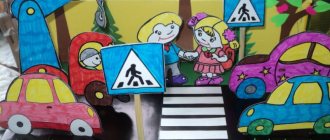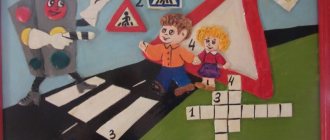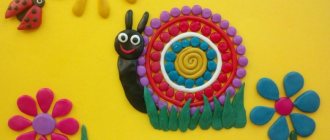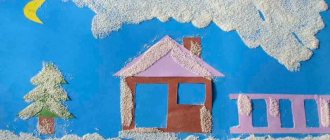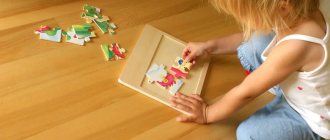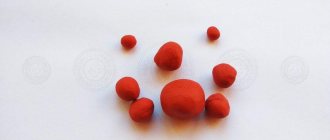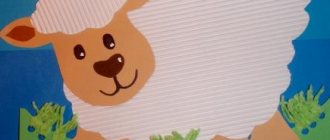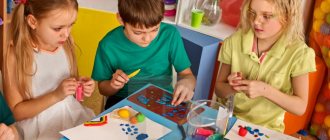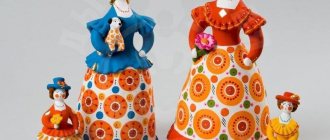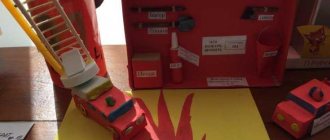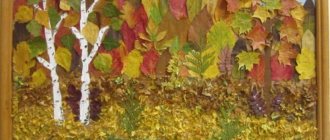In this article you will find many ideas for modeling from plasticine with step-by-step instructions and photos, as well as what crafts you can do with a child at different ages.
Working with plasticine has a beneficial effect on a child's development. These activities improve memory, attention, have a good effect on thinking, develop fine motor skills of the hands, which in turn contributes to the development of speech, form the imagination, open up creative abilities, and force one to exercise imagination. You will learn more about the benefits of practicing with plasticine and other materials in the article Let’s sculpt with children from plasticine. Plasticineography
Age category
It is recommended to start making simple crafts from plasticine from the age of one. However, each child needs an individual approach. First you need to show your child how to make a craft from plasticine, and if he shows interest, then you can continue the process with him. Otherwise, leave your classes for a later time.
From 1 to 3 years old, children begin to control their hands; at this age it is advisable to accustom the child to simple activities:
- Knead the plasticine;
- Tear off pieces from it;
- Roll into balls;
- Crush and flatten the balls with your palms or suitable objects;
- Roll rolls of various thicknesses and lengths;
- Wrap the rolls in rings;
- Sculpt a whole craft from individual parts.
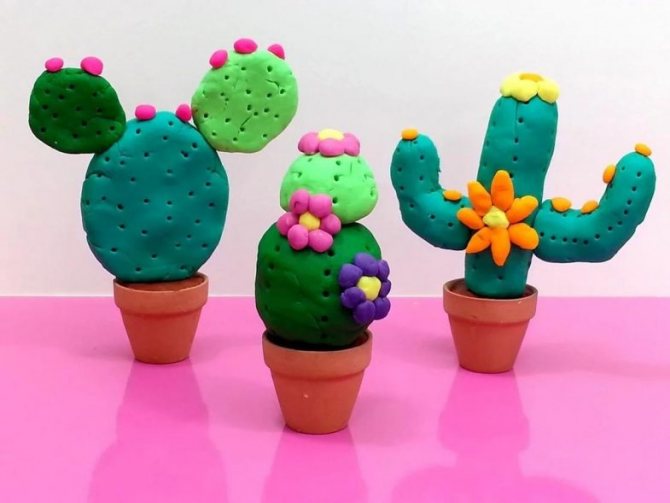
For children of this age group, it is advisable to purchase air plasticine.
From 3 to 5 years old, a child already has full control of his hands and can sculpt from ordinary plasticine, and he can make crafts that are more complex, interesting, and carry some meaning.
Preparation for class
Drawing with plasticine on cardboard seems difficult only from the outside. You cannot force a child to sit down right away to make a picture if he is not interested in it. It’s better to start doing creative work on your own in front of his eyes, saying your actions out loud.
Bright colors and curiosity should do their job, and the baby will come to the table, you should ask him to help you. It’s worth buying a frame and offering to create a gift for one of your relatives. In order not to discourage his interest, you need to be well prepared for plasticineography.
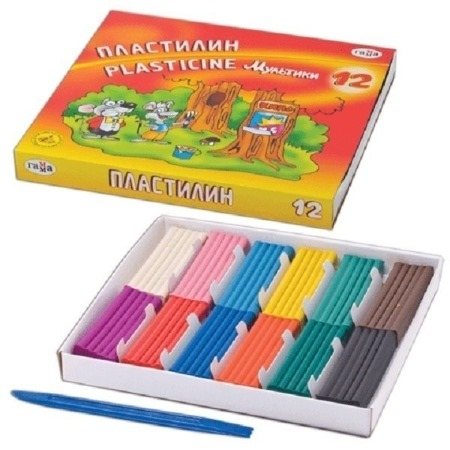
Plasticine of at least 8 colors is best suited for plasticine painting.
To do this, you should purchase the following set:
- Plasticine. It is better to take a package that contains no more than 8 colors. Otherwise, the child will be more distracted - you need to show that they can be mixed to get new shades.
For kids, you need to purchase wax plasticine. It is much softer and more convenient for them to work with, otherwise they will have to warm it up.
- Thick cardboard (can be multi-colored). Such material does not deform during sculpting, and a sheet of paper will have to be constantly held and adjusted.
In younger groups, it is better to cover it with tape so that the plasticine slides on it more easily and there is no chance of leaving greasy stains on which the material cannot be stuck.
You will also need a board and sticks
- Board. It is better to prepare the plasticine on a separate surface, creating a new model for the drawing, and then transfer it to the main sheet.
- A glass of water and wet wipes. Sometimes you will have to wet your palms so as not to get them dirty and wipe them.
- Stacks. Special plastic knives designed for plasticine, but they will be needed a little later, when the child is already familiar with this creativity.
- Image. You can take it from any children's coloring book, draw it yourself, and an older child can come up with a theme himself.
If this is your first time drawing with plasticine, then you can buy a ready-made kit for such creativity, which is now sold in stores in a wide range. Children generally have enough perseverance for 30 minutes. Therefore, the younger group should not be offered difficult work.
It is necessary to choose the right workplace, which should be well lit and familiar to the child. In order for him not to be distracted, you need to turn off the TV, put smartphones, tablets and other distracting items away.
Subjects
You can play grocery store with your children by making food crafts from airy plasticine. The child will really like this game, especially if you choose plasticine in bright, beautiful colors for this purpose.
You can mold anything from any plasticine. The main thing is that the baby likes it. Most often they make crafts from plasticine on the topic:
- Animal world. A popular topic among children of different ages and genders.
- Vegetable world. The types of crafts depend on the imagination and age of the child.
- Food. A theme for any age. Little kids can make vegetables and fruits, and older children can make cakes, pastries, and restaurant dishes with beautiful decorations.
- Thematic figures. For each event, you can create symbolic figures that can lift the spirits of adults and children.
To make crafts you will need a special plastic tool. Often it comes complete with plasticine.
The benefits of plasticine painting for child development
Plasticine is the main material in such work, the weight, shape and flexibility of which the child can feel independently. At the same time, fine motor skills of the fingers develop well, and this is very important when preparing to write with a pen.
By making a drawing using the sculpting method, he, unnoticed by himself, learns to plan his work, and, when he becomes interested, to bring it to the end, which is difficult to achieve in children.
Drawing with plasticine on cardboard or plasticine printing is a fun and useful activity for children.
Each age has its own tasks that are aimed at helping in a specific area of development:
- At 2-3 years old, in addition to hand motor skills, drawing with plasticine stimulates speech skills.
The child needs to be interested by coming up with an object from minimal details together in order to quickly complete the work and get satisfaction from it. The presence of an adult is mandatory, and he should help with choosing an image and help develop perseverance, accuracy and concentration.
- At 4-6 years old, the child is already interested in creativity, and the parents’ work with him strengthens the psycho-emotional connection between them.
Each time you sculpt, the coordination of finger movements and the eye develops. It is at this age that children enjoy creating collectively, where communication skills are established. They begin to explain their choice, refuse correctly, proving that they are right.
At 7-8 years old, a child already reveals his creative abilities
- At 7-8 years old, having already had some experience working with plasticine, the child approaches drawing with this material creatively, opening up new possibilities.
Now it is better to let them create pictures on their own that will express his emotions, dreams, and also relieve him of the resulting stress and negative thoughts. Like any creativity, this activity technique allows children to express themselves.
Materials and tools for modeling
In addition to the spatula, it is worth thinking about preparing the workplace.
Suitable working surface:
- Special board;
- Oilcloth;
- Sheet of cardboard;
- Kitchen cutting board.
Some natural and artificial materials may also be useful, such as:
- Cones;
- Nuts;
- Pebbles;
- Beads;
- Rhinestones, etc., it all depends on the intended product.
Step-by-step description (instructions)
Having prepared everything you need, you can start working. It is advisable to create crafts from plasticine step by step, paying attention to each stage of the process.
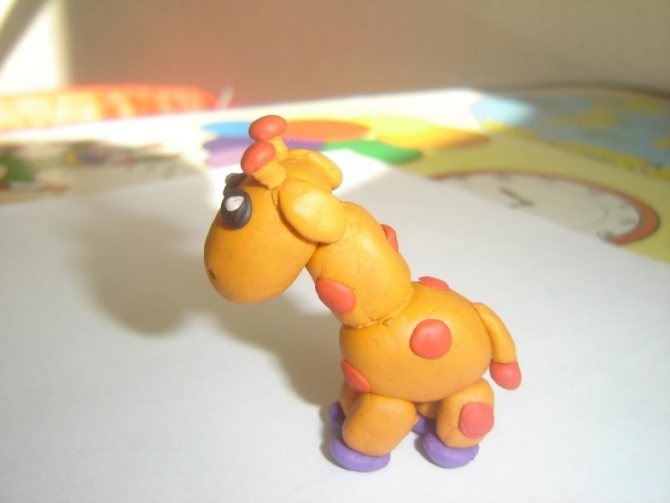
During your first lessons with your child, it is better to create simple figures from plasticine. You can start by teaching him how to roll balls. Afterwards it is possible to make various insects or a miniature zoo out of them.
Open lesson on modeling in the middle group according to the Federal State Educational Standard
Conducting open classes is part of the teacher’s job. This is not a testing event for children; their level of preparation and knowledge will not be assessed. The teacher strives to show the effectiveness of his work. Pedagogical findings and the author’s methods of presenting material are also shared in an open form.
Children should be calm, explain that strangers are just spectators
The lesson can be attended by methodologists, preschool employees, teachers from other kindergartens, students and young professionals.
Methodologists are present at the lesson as inspectors. The following aspects are assessed:
- Availability of detailed lesson notes.
- The topic of the lesson, its relevance for the middle group.
- A variety of pedagogical techniques and their correspondence to the characteristics of the group.
- Implementation of an individual-personal approach to learning.
- Maintaining a positive emotional background.
- Using computer technology in the classroom.
- Achieving set goals and objectives.
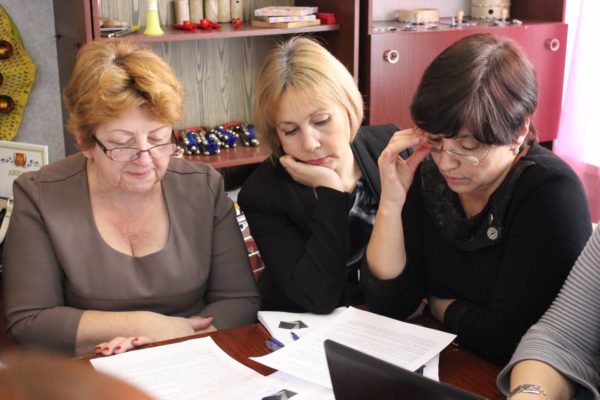
Methodologists evaluate the lesson and its documentation (notes, preliminary work plan, appendices)
Preparing for an open lesson is no different from preparing for any planned lesson. The teacher works with children, never for the sake of observers.
Have a recording device (camera or tablet) ready to video record the session. This material can be posted on pedagogical portals.
Candy on a plasticine stick
Plasticine lollipops will attract kids with their various bright colors. To work you will need a set of plasticine and skewers for canapés.
- You need to roll colorful balls.
- Roll them into thin sausages.
- Then you can make lollipops of different shapes from them.
For example, twist two sausages into spirals, braids, etc. String the finished candies onto sticks.
Owl
When the baby has practiced making a simpler owl, it’s time to move on to a more complex pattern. Here you will need more subtle and careful work - it is very useful for both motor skills and perseverance.
Photo: vedeneevaanya.blogspot.com
Paper crafts for children: 8 simple and beautiful ideas
Hedgehog with plasticine seeds
Making a hedgehog is not difficult; you will need brown plasticine for the body, beads for the eyes and nose, and seeds for the spines.
- Roll a ball out of plasticine.
- Pull it out on one side to create a teardrop shape.
- Attach eyes and nose.
- Place the seeds all over the hedgehog's back, sharp side up.
- You can place a miniature plasticine apple or mushroom on the needles.
Applications
In applications, plasticine is used to make individual parts convex and voluminous. Any picture immediately comes to life and looks much more interesting!
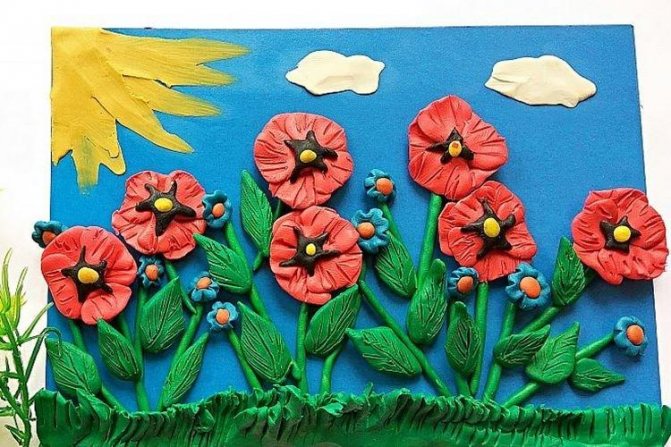
Photo: podelunchik.ru
10 ideas on how to make a lapbook with your own hands
Bouquet of flowers made of plasticine
Plasticine bouquets can be very diverse, you just need to show your imagination. For the simplest option you need:
- Take pink, red and green plasticine.
- Roll thin green sausages and cut into seven pieces of equal length.
- Roll a pink sausage and flatten it, forming a strip.
- Cut the strip into seven parts, which must be rolled into spirals (buds).
- Plant the buds on green stems.
- Collect a bouquet and decorate with a red plasticine bow.
Master Class
- The first thing they do is prepare the flagella. The syringe is filled with pieces of plasticine and pressed with a piston.
- Place horizontally in hot water for five minutes or heat in the microwave.
- The syringe is taken out and plasticine threads of the required length are squeezed out.
- Children are given cardboard with an outline and flagella for laying out the picture.
Round figures (apple, cherry, flower centers) are filled according to the same pattern. First, the end of the flagellum is glued in the center. Then they twist it in a spiral, filling the entire space. On all non-round silhouettes (pear, leaves), thin sausages are glued in the reverse order: from the contour line to the middle or in a zigzag, trying not to leave gaps.
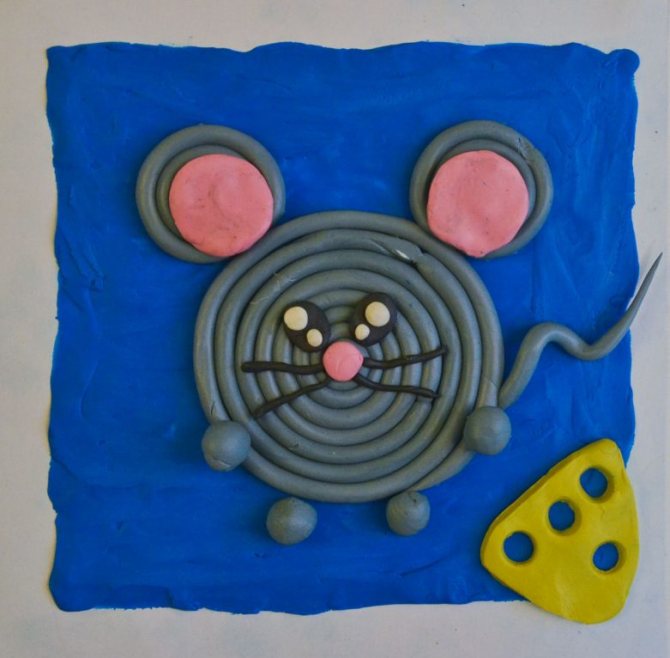
Christmas tree made of plasticine
On the eve of the New Year, you can create a beautiful Christmas tree with your child. All you need is green plasticine, a bamboo stick and scissors.
- Make a green cone of any size from plasticine.
- Place it on a stick that acts as a stem.
- Using scissors, cut the sides of the cone, creating needles, then slightly bend them upward.
Plasticine turtle
A great idea would be to make a funny turtle out of plasticine together with your children.
- Roll a green plasticine ball (head).
- Make five more balls of only a smaller diameter (legs and tail).
- Roll a large brown ball and form it into a shell.
- Stick on small brown flattened plasticine circles, creating a semblance of shell texture.
- Attach the head and neck, paws and tail to the shell.
- Apply something sharp to the nostrils and mouth.
- Stick eyes.
The craft is ready!
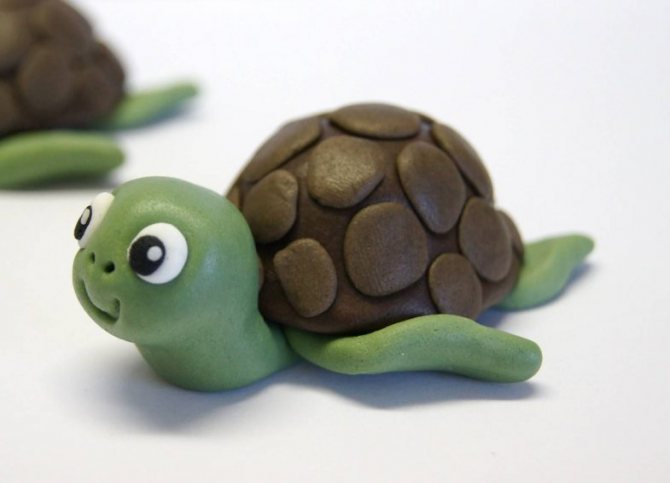
Plasticine kitten
You can trust your child to make a simple figurine of a kitten himself. All you need is regular plasticine.
Step-by-step actions:
- Tear off a small piece of plasticine of a suitable color.
- Roll out well into an oval shape.
- Form the body of the kitten.
- Roll a small ball (head) and stick it to the body.
- Make the legs by rolling four sausages.
- Attach them to the body.
- Make two pink triangles (ears).
- Roll out the sausage for the tail.
- Make eyes and nose. That's all!
If something is not clear, then photos of plasticine crafts can serve as a visual aid.
Panda
The little panda looks very neat and realistic, and making it with your own hands is as easy as shelling pears! By the way, you can use any colors and collect a whole army of colorful fantasy bears.
Photo: za.pinterest.com
DIY winter crafts for kindergarten (50 photos)
Photos of plasticine crafts
0
